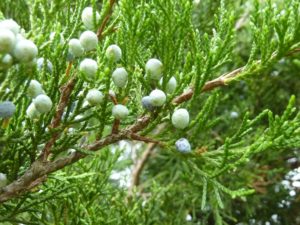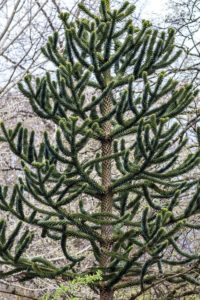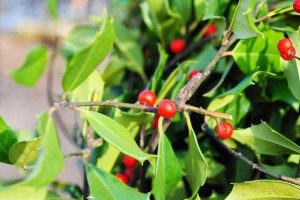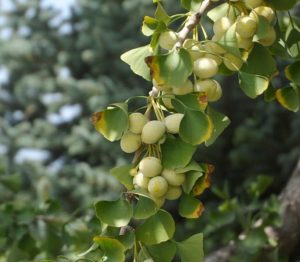THE LEAFLET

Female Trees Facts
As we reflect on Women’s History Month and the amazing contributions of female foresters, we started thinking about some other famous female in the arboriculture world – female trees. Some tree species are dioecious, meaning they produce single sex flowers (either male or female). Male flowers produce pollen and no fruits and female flowers bear seeds or fruits. Here are some dioecious trees with some particularly memorable female counterparts.

Hardy Rubber Tree (Eucommia ulmoides), an ornamental shade tree, is native to China and possibly now extinct in the wild. Dioecious with insignificant greenish brown male flowers clusters and singular female flowers, which give way to flattened ash-like winged seeds. As the common name suggests, rubber can in fact be made from the tree sap, but the extraction process is quite complicated and too costly for commercial application. Tear a leaf, break a twig or peel off some bark and a stringy latex-like sap appears.

Juniperus virginiana
The Eastern Red Cedar (Juniperus virginiana) is a common sight throughout most of the plains states and eastern United States on road cuts, in fence rows and scattered across abandoned fields – as it is an incredibly hardy tree. It is an aromatic tree, with reddish wood giving off the scent of cedar chests and crushed fruit providing a whiff of the gin they once flavored. Be wary though, these berries are actually a cone made of fused cone scales. Not just for humans, its fruit is eaten by a variety of wildlife, especially the cedar waxwing, which was named from the eastern red cedar. This tree is available through our residential planting program, RiverSmart Homes. You can get up to $50 back for planting this tree yourself through our tree rebate program.
 The Monkey puzzle tree or Chilean Pine (Araucaria araucana) is an unusual, attractive, and very interesting plant. Its common names are quite deceiving – one comes from the idea that a monkey would be unable to climb it. Although it is also referred to as the Chilean pine, it is not a member of the pine family. The modern tree is evergreen, with strange leaves, a distinctive trunk, and branches that emerge from the trunk in whorls. The female trees produce large, edible and—according to people who have eaten them—delicious seeds which are very popular in some parts of the world.
The Monkey puzzle tree or Chilean Pine (Araucaria araucana) is an unusual, attractive, and very interesting plant. Its common names are quite deceiving – one comes from the idea that a monkey would be unable to climb it. Although it is also referred to as the Chilean pine, it is not a member of the pine family. The modern tree is evergreen, with strange leaves, a distinctive trunk, and branches that emerge from the trunk in whorls. The female trees produce large, edible and—according to people who have eaten them—delicious seeds which are very popular in some parts of the world.
 The most popular dioecious landscape shrubs are the hollies (Ilex spp.). In holly world many cultivars (varieties) seem to be specially “married” to one another. Some may select female plants for their colorful fruits in fall and winter. Holly fruits may be red, yellow or white colored depending on the cultivar. Be certain that the correct pollinating variety has been planted nearby the specific female cultivar(s) – for example, the male clone ‘Apollo’ will pollinate primarily ‘Sparkleberry’ female hollies. Many types of hollies (married or not!) are available through our residential planting program, RiverSmart Homes or get up to $50 back for planting this tree yourself through our tree rebate program.
The most popular dioecious landscape shrubs are the hollies (Ilex spp.). In holly world many cultivars (varieties) seem to be specially “married” to one another. Some may select female plants for their colorful fruits in fall and winter. Holly fruits may be red, yellow or white colored depending on the cultivar. Be certain that the correct pollinating variety has been planted nearby the specific female cultivar(s) – for example, the male clone ‘Apollo’ will pollinate primarily ‘Sparkleberry’ female hollies. Many types of hollies (married or not!) are available through our residential planting program, RiverSmart Homes or get up to $50 back for planting this tree yourself through our tree rebate program.
 Last but not least how could we forget the infamous female Ginkgo trees? A throwback to prehistoric times, the gingko is a beautiful shade tree with unique fan-shaped leaves that turn a beautiful yellow in fall, and distinctly furrowed corky bark that is gray-white in color. This tough urban tree is able to withstand varied conditions and stresses. It’s practically perfect in every way – except for the pesky fruit that falls from female trees. Described as a frightening cocktail of dirty gym socks, rancid butter, or even vomit, the fallen fruit is certainly notorious. Not scared of the fruit and grateful for all the ginkgoes benefits? These are available through our residential planting program, RiverSmart Homes or get up to $50 back for planting this tree yourself through our tree rebate program.
Last but not least how could we forget the infamous female Ginkgo trees? A throwback to prehistoric times, the gingko is a beautiful shade tree with unique fan-shaped leaves that turn a beautiful yellow in fall, and distinctly furrowed corky bark that is gray-white in color. This tough urban tree is able to withstand varied conditions and stresses. It’s practically perfect in every way – except for the pesky fruit that falls from female trees. Described as a frightening cocktail of dirty gym socks, rancid butter, or even vomit, the fallen fruit is certainly notorious. Not scared of the fruit and grateful for all the ginkgoes benefits? These are available through our residential planting program, RiverSmart Homes or get up to $50 back for planting this tree yourself through our tree rebate program.